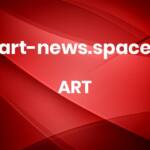As the busiest season for art in London heats up, impressive pieces of public art are taking over the city. Last week saw the launch of the annual Frieze Sculpture outdoor exhibition, with artists like Elmgreen & Dragset, Erwin Wurm, and Jaune Quick-to-See Smith filling the rolling green grounds of Regent’s Park’s English Garden. Further east, in Bromley-by-Bow, legendary 90-year-old conceptual artist Rasheed Araeen debuted a new addition to The Line public art trail. His new site-specific installation provides a welcome pop of color to the surrounding industrial cityscape.
The Frieze Sculpture selection of 14 new or recent works for its 13th edition, which runs through November 2, has once again been assembled by star curator Fatoş Üstek. Her chosen theme, “In the Shadows,” plays with sculpture’s literal, multidimensional presence, which casts shadows, as well as the term’s metaphorical possibilities, touching on absence, obfuscation, or our shared ancestry. For each work, guiding audio interpretations are offered via Bloomberg Connects.
Rasheed Araeen, Untitled The Line installed on The Line in East London. Photo: Angus Mill, courtesy of The Line.
“Darkness mostly stands for an anticipation of fear and pain,” said Üstek, but she nonetheless encourages us to step bravely into the shadows. “These shadows are deeply buried in our psyches, in our ways of being, and ways of existence,” she added. “Let’s get together and pull the veil of reality, to look underneath at what is actually happening here and now.”
With this mission in mind, the thought-provoking show never shies from complex political, ecological, and social issues. In this carefully constructed arena for deep contemplation, engaged audiences will find themselves suspended at the threshold between darkness and light.
Erwin Wurm, Ghost (Substitutes) (2022), presented by Thaddaeus Ropac at Frieze Sculpture 2025. Photo: Linda Nylind, courtesy of Frieze.
Austrian artist Erwin Wurm has gained a cult following for his absurdist works, which invite new ways of seeing everyday objects. (2022) is a painted, larger-than-life aluminum cast of a blue suit, a portrait of a person by way of their “second skin,” Wurm’s term for our clothing. The sculpture alludes to the presence of a human inhabitant but, ultimately, amplifies their absence with its rumpled, slack form. The sculpture connects this to the illusionistic nature of cast sculpture dating back to antiquity, when majestic subjects like goddesses or warriors were “defined by a very thin layer of metal and were empty inside.”
Jaune Quick-to-See Smith, King of the Mountain (2024–25), presented by Garth Greenan Gallery and Stephen Friedman Gallery at Frieze Sculpture 2025. Photo: Linda Nylind, courtesy of Frieze.
The trailblazing Native American artist Jaune Quick-to-See Smith died at the start of the year, so it is fitting to see her representing at this year’s edition of Frieze Sculpture. (2024–25), from her recent “Trade Canoe” series, belongs to a wide-ranging practice that also included printmaking, drawing, and painting. The bronze statue of a buffalo standing on a boulder in a canoe is a tribute to Big Medicine, a real albino buffalo that was born on the artist’s reservation in Montana in the 1930s and was believed to have healing powers. Suitably, the monument is raised on a plinth.
“In my art and life, I really strive to reverse the adage that what you see is what you get,” said Smith. “If I can be coyote and practice my sneak up, I can engage the viewers from a distance with one image and lure them in for exposure to another layer, which changes the initial view into quite a different reality.”
Abdollah Nafisi, Neighbours (2025), presented by Dastan at Frieze Sculpture 2025. Photo: Linda Nylind, courtesy of Frieze.
Tehran-born, U.K.-based artist Abdollah Nafisi’s strange, painted construction of salvaged steel, (2025), finds a harmonious balance among its various colorful elements. The two large horn-like forms use the wind to make sounds, imbuing the intricate structure with a surprising ephemerality.
“Even though the steel feels heavy and grounded, I’ve built the work to feel like it’s holding its breath, like it could shift at any moment,” said Nafisi. “That tension invites something more fragile, like presence or silence or even memory.”
David Altmejd, Nymph 1 Nymph 2 Nymph 3 (2025), presented by White Cube at Frieze Sculpture 2025. Photo: Linda Nylind, courtesy of Frieze.
Three frolicking nymphs by Canadian sculptor David Altmejd are caught in motion, clothes twirling and limbs kicking out in a moment of joyously free expression. The beautiful folkloric spirits known as nymphs have an affinity with nature, and Altmejd captures something of their carefree whimsy. As they slip past our eye, we can only wonder if what we thought we saw was real of imagined.
“At first their grace draws you in, but up close their rough, pitted texture reveals a raw and tactile energy,” said Üstek. “But nymphs are wild, unstable forces caught between creation and disintegration.”
Assemble, Fibredog (2025), presented by Plinth at Frieze Sculpture 2025. Photo: Linda Nylind, courtesy of Frieze.
The biggest and perhaps most memorable work included in this year’s Frieze Sculpture is (2025), a playful sculpture of a scruffy dog made by the London-based collective Assemble. With ritual central to their practice, the group gathered spare wood and thatch from Regent’s Park and its surroundings and its charmingly makeshift appeal brings to mind ancient ceremonies and folklore. Now, it stands proudly as a spot that welcomes people to gather.
“Inspired by a dead tree trunk, they have bound together branches of straw, thatch, and timber into a totem-like form or effigy,” said Üstek. “It has the feeling of something mythic, like it has always been there, waiting to be noticed.”



